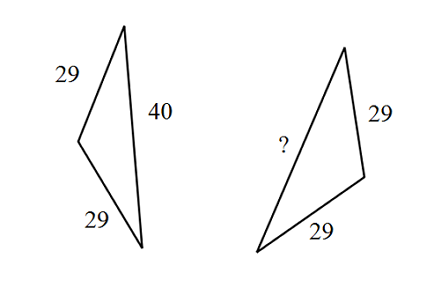Is Heron necessary?
 The two non-similar isosceles triangles in the above diagram have an equal area. The left one has side lengths 29, 29, 40; the right one has side lengths 29, 29 and an unknown number. What is this unknown side length?
The two non-similar isosceles triangles in the above diagram have an equal area. The left one has side lengths 29, 29, 40; the right one has side lengths 29, 29 and an unknown number. What is this unknown side length?
The answer is 42.
This section requires Javascript.
You are seeing this because something didn't load right. We suggest you, (a) try
refreshing the page, (b) enabling javascript if it is disabled on your browser and,
finally, (c)
loading the
non-javascript version of this page
. We're sorry about the hassle.
We can divide the 2 9 / 2 9 / 4 0 triangle into two congruent right triangles with base length 2 0 , height x and hypotenuse length 2 9 . By Pythagoras, we then have that x 2 + 2 0 2 = 2 9 2 ⟹ x = 2 1 . The area of the original triangle is then 2 ∗ 2 2 0 ∗ 2 1 = 4 2 0 .
Similarly dividing the "mystery" triangle into two congruent right triangles with base length b and height h we have that b 2 + h 2 = 2 9 2 and b h = 4 2 0 , (due to the "equal area" condition). We then have that
( b + h ) 2 = b 2 + h 2 + 2 b h = 2 9 2 + 2 ∗ 4 2 0 = 1 6 8 1 ⟹ b + h = 4 1 ⟹ b h = b ( 4 1 − b ) = 4 2 0
⟹ b 2 − 4 1 b + 4 2 0 = 0 ⟹ ( b − 2 0 ) ( b − 2 1 ) = 0 .
Thus b = 2 0 or b = 2 1 . Since we have already been given the b = 2 0 triangle, the unknown side length must be 2 ∗ 2 1 = 4 2 .